load capacity PONTIAC BONNEVILLE 1993 Owners Manual
[x] Cancel search | Manufacturer: PONTIAC, Model Year: 1993, Model line: BONNEVILLE, Model: PONTIAC BONNEVILLE 1993Pages: 322, PDF Size: 16.31 MB
Page 184 of 322
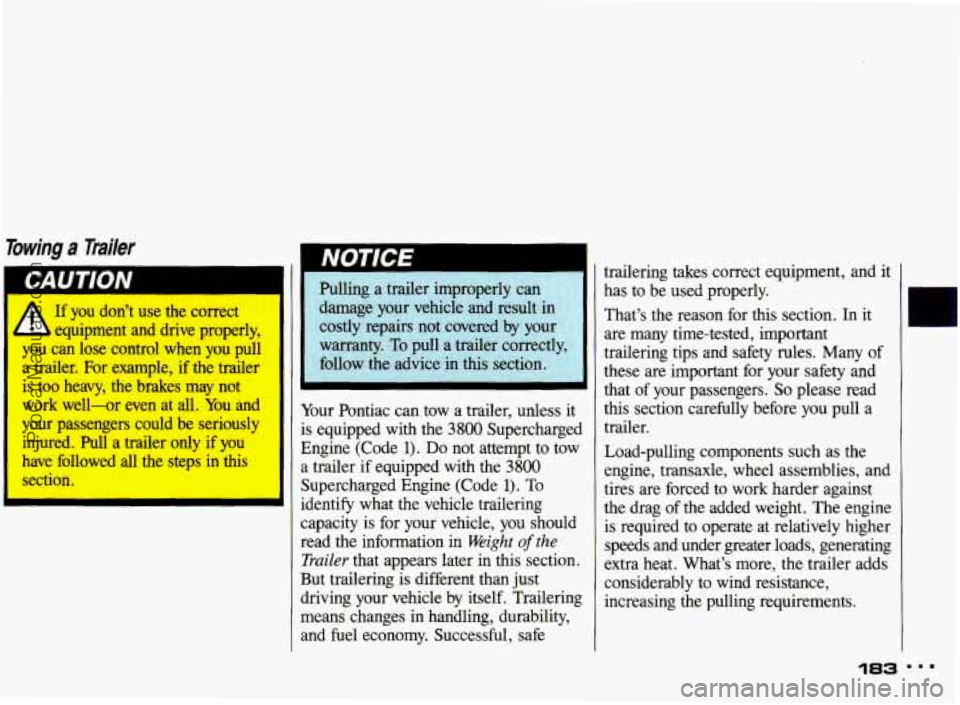
Towing a Tmiler
I
If you don't use the correct
equipment and drive properly,
you can lose control when you pull
a trailer. For example, if the trailer
is too heavy, the brakes may not
work well-or even at all. You and
your passengers could be seriously injured. Pull a trailer only if you
have followed all the steps in this
section.
NOTICE
I I; Pulling a trailer improperly can : __
damage your vehicle and result in' ;'
costly repairs not covered by your
follow the advice in this section.
Your Pontiac can tow a trailer, unless it
is equipped with the
3800 Supercharged
Engine (Code
1). Do not attempt to tow
a trailer
if equipped with the 3800
Supercharged Engine (Code 1). To
identify what the vehicle trailering
capacity is for your vehicle,
you should
read the information in
Weight of the
Trailer that appears later in this section.
But trailering is different than just
driving your vehicle by itself. Trailering
means changes in handling, durability,
and fuel economy. Successful, safe trailering
takes correct equipment, and it
has to be used properly.
That's the reason for this section.
In it
are many time-tested, important
trailering tips and safety rules. Many
of
these are important for your safety and
that of your passengers.
So please read
this section carefully before you pull a
trailer.
Load-pulling components such as the
engine, transaxle, wheel assemblies, and
tires are forced to work harder against
the drag of the added weight. The engine
is required to operate at relatively higher
speeds and under greater loads, generating
extra heat. What's more, the trailer adds
considerably to wind resistance,
increasing the pulling requirements.
ProCarManuals.com
Page 186 of 322
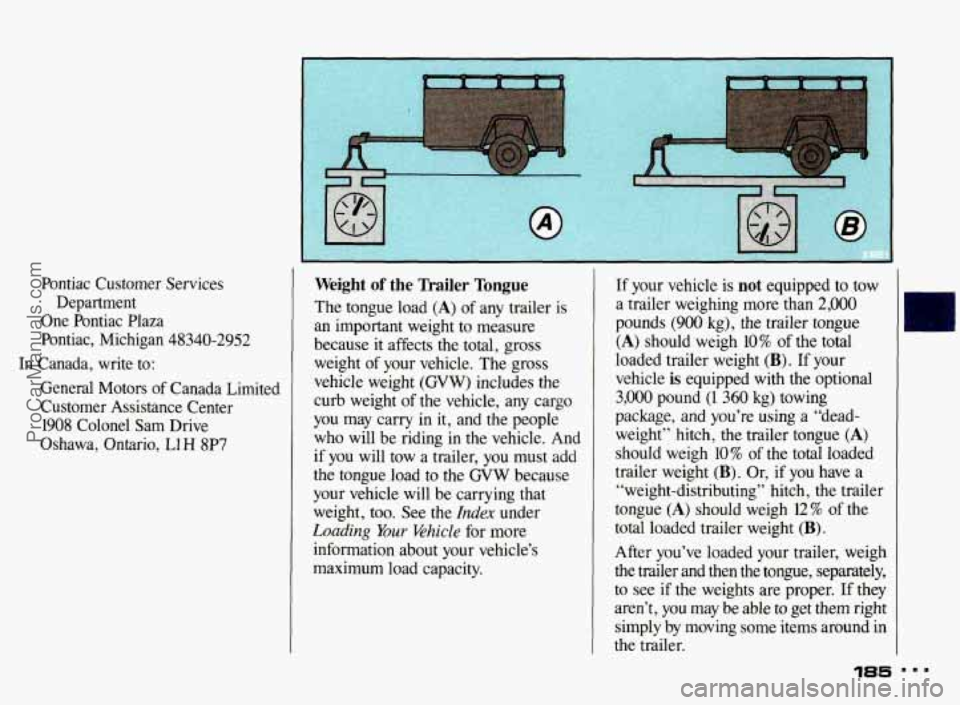
Pontiac Customer Services Department
One Pontiac Plaza
Pontiac, Michigan 48340-2952
In Canada, write to:
General Motors of Canada Limited
Customer Assistance Center 1908 Colonel Sam Drive
Oshawa, Ontario,
L1H 8P7
Weight of the nailer Tongue
The tongue load (A) of any trailer is
an important weight to measure
because it affects the total, gross
weight of your vehicle. The gross
vehicle weight
(GVW) includes the
curb weight
of the vehicle, any cargo
you may carry in it, and the people
who will
be riding in the vehicle. And
if you will tow a trailer, you must add
the tongue load to the
GVW because
your vehicle will be carrying that
weight, too.
See the Index under
Loading Your &hide for more
information about your vehicle’s
maximum load capacity.
If your vehicle is not equipped to tow
a trailer weighing more than
2,000
pounds (900 kg), the trailer tongue
(A) should weigh 10% of the total
loaded trailer weight
(B). If your
vehicle
is equipped with the optional
3,000 pound
(1 360 kg) towing
package, and you’re using a “dead-
weight” hitch, the trailer tongue
(A)
should weigh 10% of the total loaded
trailer weight
(B). Or, if you have a
“weight-distributing” hitch, the trailer
tongue
(A) should weigh 12% of the
total loaded trailer weight
(B).
After you’ve loaded your trailer, weigh
the trailer and then the tongue, separately,
to see if the weights are proper.
If they
aren’t,
you may be able to get them right
simply by moving some items around in
the trailer.
185
ProCarManuals.com
Page 249 of 322
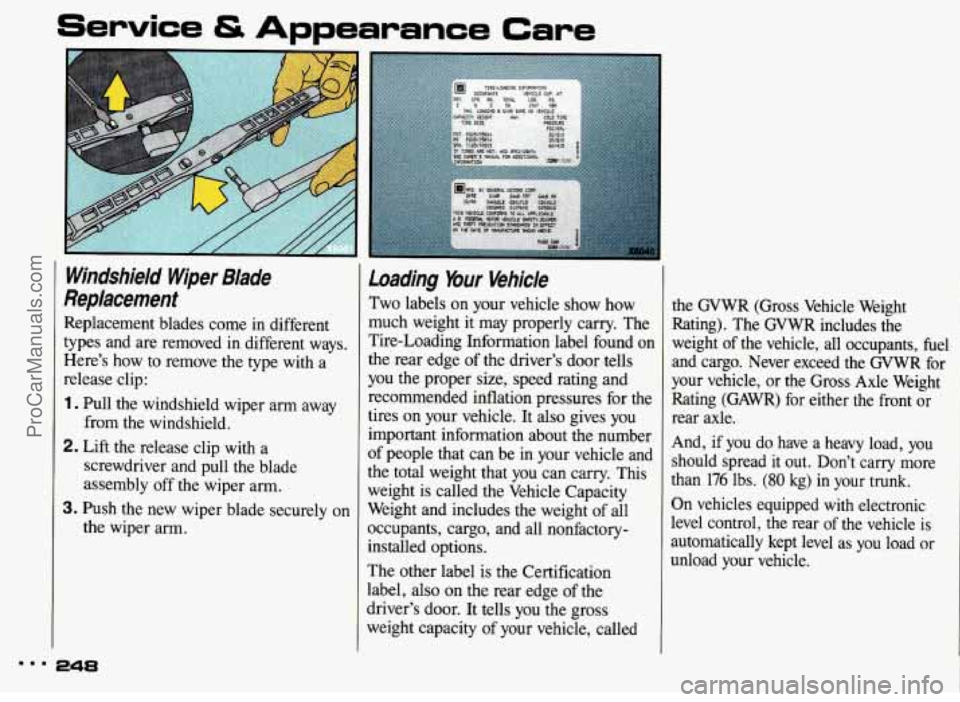
Service & Appearance Care
Windshield Wiper Blade
Replacement
Replacement blades come in different
types and are removed
in different ways.
Here’s how to remove the type with a
release clip:
1. Pull the windshield wiper arm away
2. Lift the release clip with a
from
the windshield.
screwdriver and pull the blade
assembly off the wiper arm.
the wiper arm.
3. Push the new wiper blade securely on
Loading bur Vehicle
Two labels on your vehicle show how
much weight it may properly carry. The
Tire-Loading Information label found on
the rear edge of the driver’s door tells
you the proper size, speed rating and
recommended inflation pressures for the
tires on your vehicle. It also gives you
important information about the number
of people that can be in your vehicle and
the total weight that you can carry. This
weight is called the Vehicle Capacity
Weight and includes the weight of all
occupants, cargo, and all nonfactory-
installed options.
The other label is the Certification
label,
also on the rear edge of the
driver’s door. It tells you the gross
weight capacity of your vehicle, called the
GVWR (Gross Vehicle Weight
Rating). The GVWR includes the
weight of the vehicle, all occupants, fuel
and cargo. Never exceed the GVWR for
your vehicle, or
the Gross Axle Weight
Rating (GAWR) for either the front or
rear axle.
And, if you do have a heavy load,
you
should spread it out. Don’t carry more
than
176 lbs. (80 kg) in your trunk.
On vehicles equipped with electronic
level control, the rear of the vehicle
is
automatically kept level as you load or
unload your vehicle.
... 248
ProCarManuals.com
Page 256 of 322
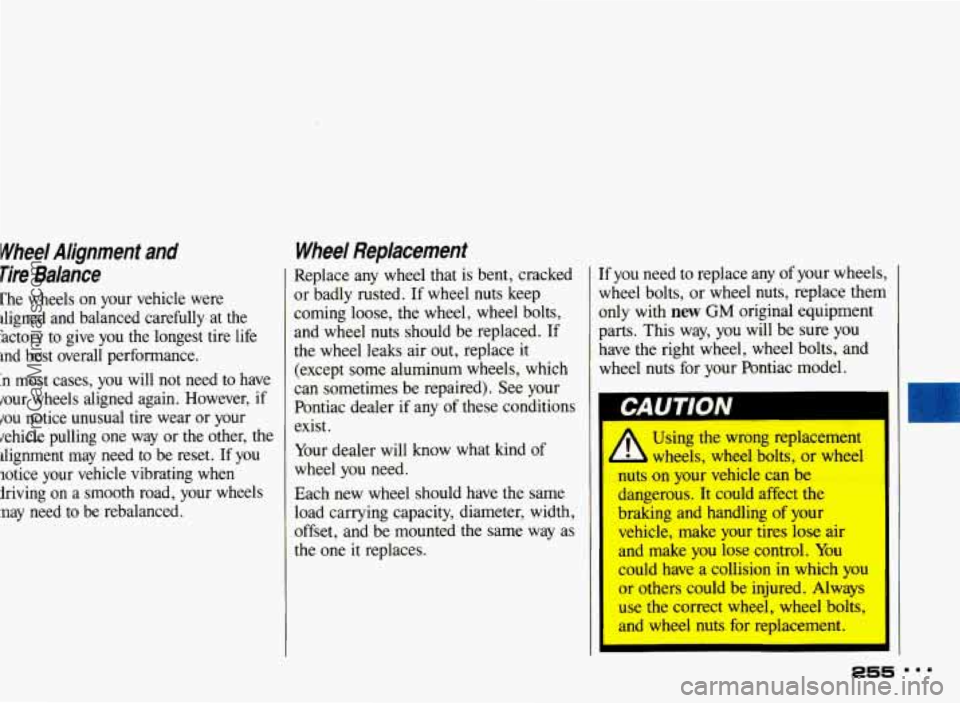
Wheel Alignment and
Tire Balance
The wheels on your vehicle were
iligned and balanced carefully at the
'actory to give you the longest tire life
md best overall performance.
:n most cases, you will not need to have
jour wheels aligned again. However, if
jou notice unusual tire wear or your
iehicle pulling one way or the other, the
dignment may need to be reset. If you
lotice your vehicle vibrating when
hiving on a smooth road, your wheels
nay need to be rebalanced.
Wheel Replacement
Replace any wheel that is bent, cracked
or badly rusted.
If wheel nuts keep
coming loose, the wheel, wheel bolts,
and wheel nuts should be replaced.
If
the wheel leaks air out, replace it
(except some aluminum wheels, which
can sometimes be repaired). See your
Pontiac dealer if any of these conditions
exist.
Your dealer will know what kind of
wheel you need.
Each new wheel should have the same
load carrying capacity, diameter, width,
offset, and be mounted the same way as
the one it replaces. If you need to replace any
of your wheels,
wheel bolts, or wheel nuts, replace them
only with
new GM original equipment
parts. This way, you will be sure
you
have the right wheel, wheel bolts, and
wheel nuts for your Pontiac model.
A
Using the wrong replacement
wheels, wheel bolts,
or wheel
nuts on your vehicle can be
dangerous. It could affect the
braking and handling
of your
vehicle, make your tires lose air
and make you lose control. You
could have a collision in which you
or others could be injured. Always
use the correct wheel, wheel bolts,
and wheel nuts for replacement.
ProCarManuals.com
Page 321 of 322
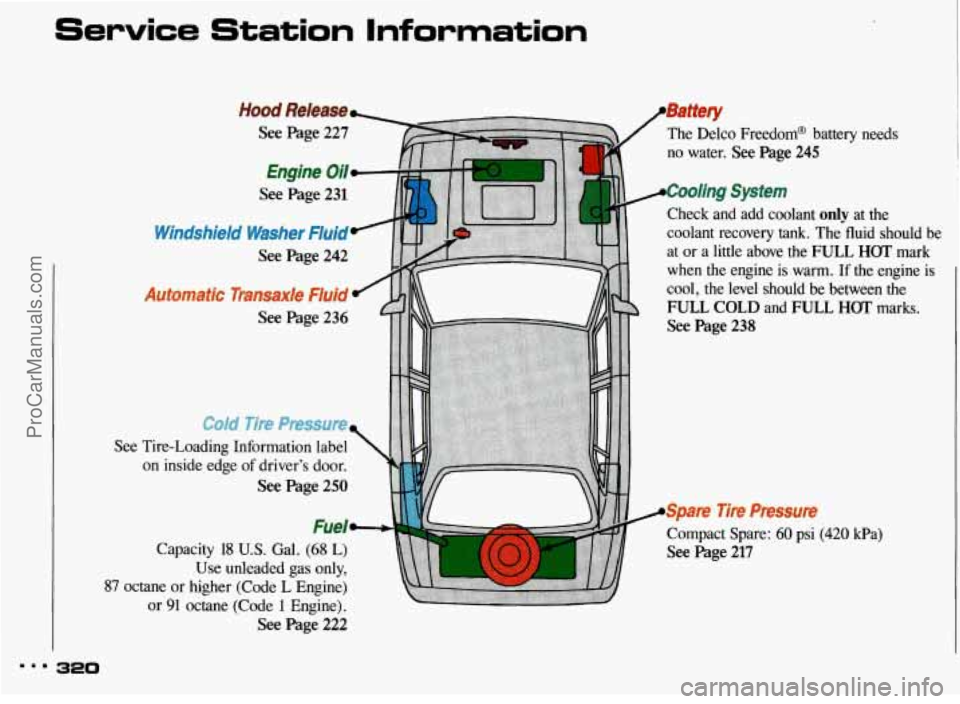
Service Station Information
See
87 oc
Hood Release-
See Page 227 The Delco Freedom@ batter
no water.
See Page 245
Engine 011
See Page 231
See Page 242
See Page 236
Tire-Loading Information label on inside edge
of driver’s door.
See Page 250
Fuel-
Capacity 18 U.S. Gal. (68 L)
Use unleaded gas only,
:&ne or higher (Code L Engine)
or
91 octane (Code 1 Engine).
y needs
Check and add coolant
only at the
coolant recovery tank. The fluid should be
at or a little above the
FULL HOT mark
when the engine is warm. If the engine
is
cool, the level should be between the
FULL COLD and FULL HOT marks.
See Page 238
Compact Spare: 60 psi (420
See Page 217
See Page 222
-.
8.. 320
ProCarManuals.com